Midleton Hurling and Football, Ladies Football and Camogie Club News
31 January, 2021
The key messages for this week:
- New GAA COVID Guidelines and Useful Numbers
- Lotto Jackpot reaches €20,000
- Cork County Board Draw….Rebels’ Bounty tickets on sale
- Clonmult Ambush Centenary Commemoration…Portrait of Patriots Series
- Blast from the Past images
Midleton GAA…at the ‘Heart of the Community’. Ní neart go cur le chéile. There is no strength without unity.
COVID Update


The GAA has issued advice to clubs and counties for activities that are permissible and not permissible in 2021 until further notice.
- Under Level 5 of the plan for living with Covid-19 and the current restrictions in the North, individual training only is permitted for GAA clubs.
- Neither adult or underage teams may train collectively, club games are not permitted, and GAA club grounds must remain closed.
- At inter-county level, it remains the case that collective training for senior inter-county panels may only recommence from January 15th. However, given the current growth rates in virus transmission, this date is under review.
- For the moment senior inter-county players may train on an individual basis only in club or county owned gyms and no training is currently permitted for any other panels such as U-20 or Minor.
For more detailed guidelines please click here.
Useful Numbers
As Level 5 restrictions continue it is important to remember that you are not alone.
Here are some useful numbers to keep in mind
- Mental Health Information Line 1800 111 888
- Samaritans 116 123
- Pieta House 1800 247 247
- Aware 1800 80 48 48
- Women’s Aid 1800 341 900
- Men’s Aid Ireland 01 5543811
- Elder Abuse Helpline 1850 241 850
- Free 24/7 Text Line Text TALK to 50808
- Childline 1800 66 66 66 or Text 50101
- Alcoholics Anonymous 01 842 0700
- Gamblers Anonymous Cork 087 285 9552
- Gardaí 999 or 112
- Midleton Garda Station 021 4621550
Mega Lotto Results
- 4 Lucky Dip Prize Winners this week
- The re-launched Lotto is a critical component of our fundraising for Park South. The support to date has been good, especially with the number of annual subscriptions that have been submitted.
- In total Midleton GAA will give out local business vouchers to the value of €3,800 every year as part of our “Shop Local, Buy Local” campaign.
- How to play: Go to http://www.midletongaa.com click on Play Now in Mega Lotto section. You can buy an annual ticket by selecting “50” from the “Number of Draws” to Play dropdown.
Rebels’ Bounty Draw
The Cork County Board Draw has been re-name Rebels’ Bounty 2021. This is a fund-raiser not just for the Cork County Board but also for GAA clubs within the county. Midleton GAA are promoting Rebels’ Bounty Draw as a vehicle to raise funds for our new facilities at Park South.
All monies collected, YES, that's 100% of it goes directly to the Midleton GAA club without any admin costs, any risks or any prize costs. Many long term members are renewing now and many new members joining due to the new attractive prizes.
As you can see from the below image, there is now a total prize fund of €500k with a Whopping €100k for December 21 Draw. There are 360 cash prizes in total per year.
Purchase a ticket to support the GAA and especially Midleton GAA – Magpies Abú
To sign up for the draw simply click on the joining link:
https://rebelsbounty.ergogroup.ie/prod/rebelsbounty/join-draw
If you have any queries/questions or need help purchasing a ticket, you can contact the following people who will be delighted to assist you. Many thanks for all your support over the years which has enabled Midleton GAA to thrive and remain a forward-thinking and proactive club and strive to always be better for all our members and our community.
Pat O Brien - Coordinator Club Draw Coordinator 086 8118815
Liam Ryan, Steve Sheehan, Pearse Mc Carthy, John Fenton, Diarmuid Ó Dálaigh
Go raibh maith agaibh. Thank you.


Juvenille
Junior Infants Boys Pre-Registration
The ongoing Govid-19 government restrictions has meant that the most important boy’s team in the club, the new Fé6 Junior Infants Boys, haven’t been able to commence their GAA training yet. We hope that once the restrictions are lifted, this group will join all their teammates in Midleton GAA Club on the training fields. We also hope that official Club registration will take place when restrictions allow. In the meantime, if any parents of Junior Infant Boys wish to submit their details including name/ number/ email, they can do so to our Juvenile Secretary Michael Carroll at secretarybng.midleton.cork@gaa.ie or to 086-8362218.
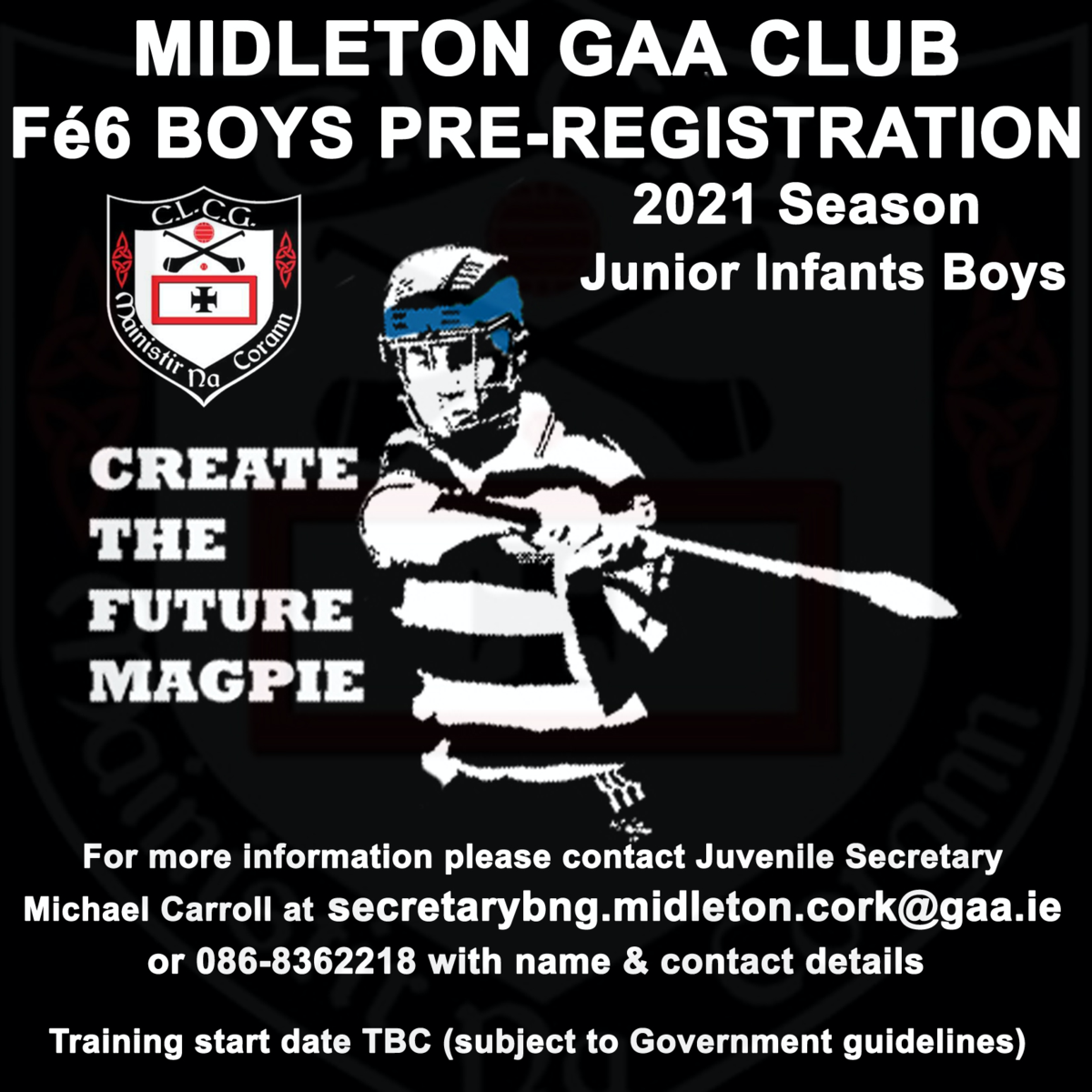
Healthy Club Project
Upcoming Webinars
Changing Gears: Programme designed to help people who are 50+ to manage health challenges. To book contact Fiona Holohan at engage@ageandopportunity.ie Dates: Tue 2nd, 9th, 16th, 23rd February and 2nd and 9th March 2021 Time: 2.00 – 4.00 pm
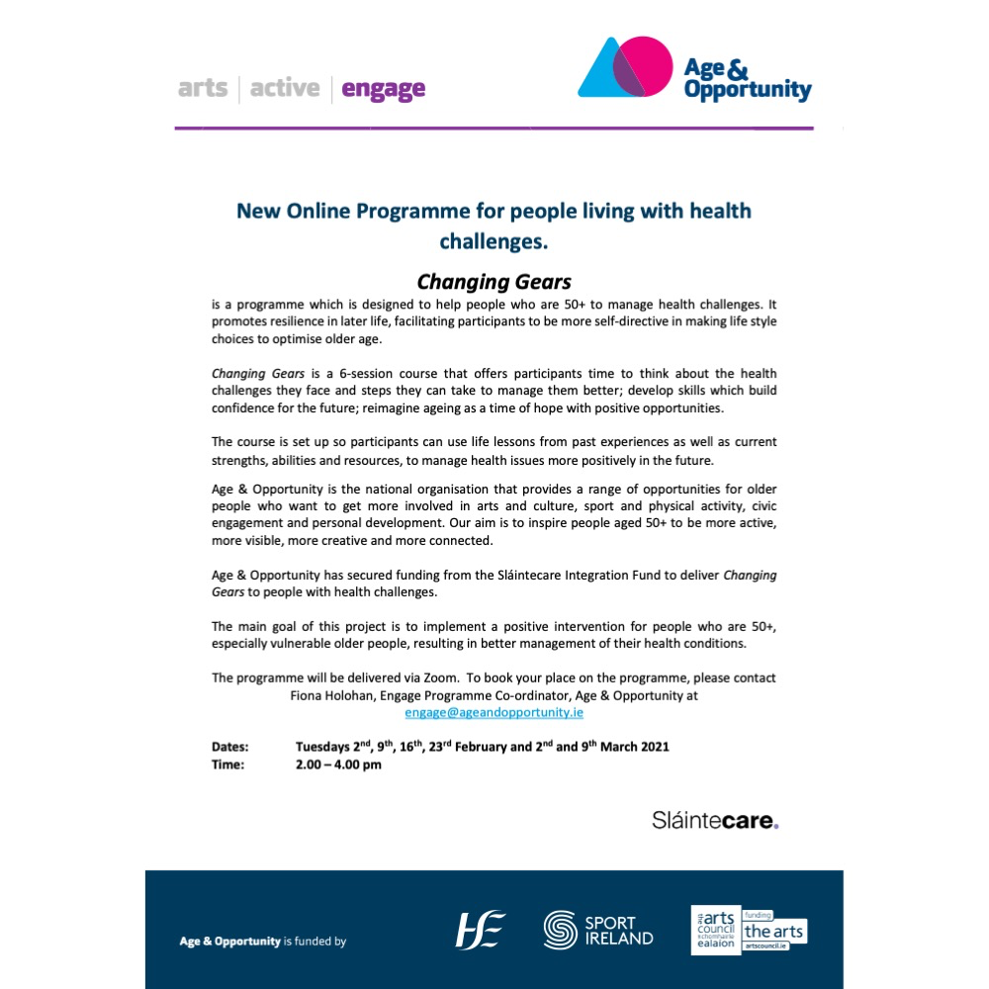
GAA Diversity & Inclusion Webinars: 4 Tuesdays in February. REGISTER NOW at https://learning.gaa.ie/officertrainingcalendar
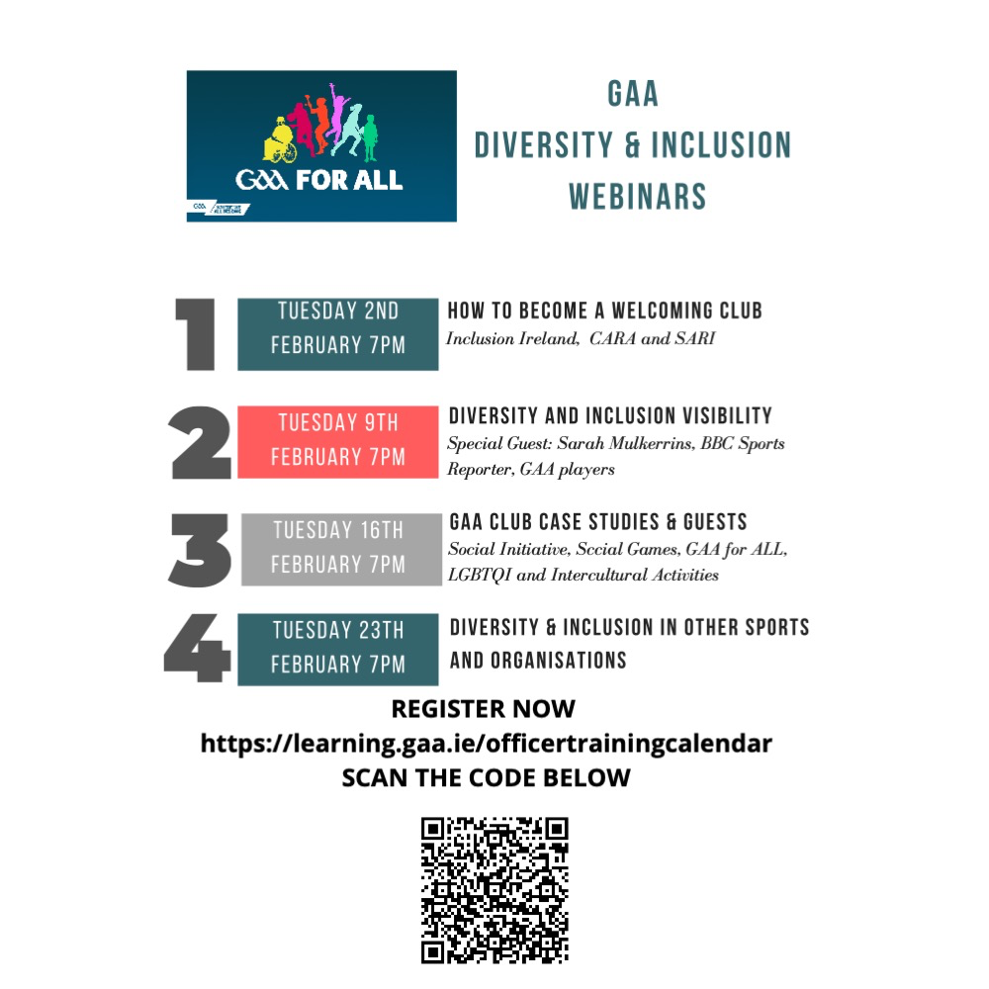
Safeguarding, Vetting & Coaching
Any person who carries out a role of responsibility such as coaching, managing or training underage teams, or any team that has a player under 18 years of age must be vetted. The National Vetting Bureau Act 2012-2016 makes vetting a statutory obligation and therefore applies to everyone working with children. Vetting can be done online through the E Vetting system. Vetting is now valid for three years instead of five years as it was in the past. You will be contacted by the club in the next couple of weeks if you need to renew. Anyone vetted between Jan 16 and Jan 19 must now be revetted.
The GAA is committed to creating and maintaining the safest possible environment for all young people who wish to participate. In an attempt to achieve this for all our underage players, coaches must complete a Safeguarding 1 workshop as highlighted in the Children First as one of the mandatory requirements.
The club will host a Safeguarding training online on Tuesday 2nd March at 7pm. This will take approx 2.5/3 hours.
To facilitate those who require foundation training the club will host a training on Monday 8th Feb at 7pm. This will involve an hour online with some further online work to be done in your own time and a final practical piece to be completed when the restrictions lift.
To book either of these trainings or for assistance with vetting please email childrensofficermidletongaa@gmail.com or text Jerome Curtin ( Midleton GAA Children’s Officer) at 087 2100989
Midleton GAA have always been compliant with regard to these mandatory requirements so it would be great to have everything updated during this period of closure so we will be ready to get back to action without delay when the time comes.
Blast from the Past
This week’s features are the Minor Panel from 2000, a St Marys team from c1982 and the 1974 U14 panel who were County Shield Winners.
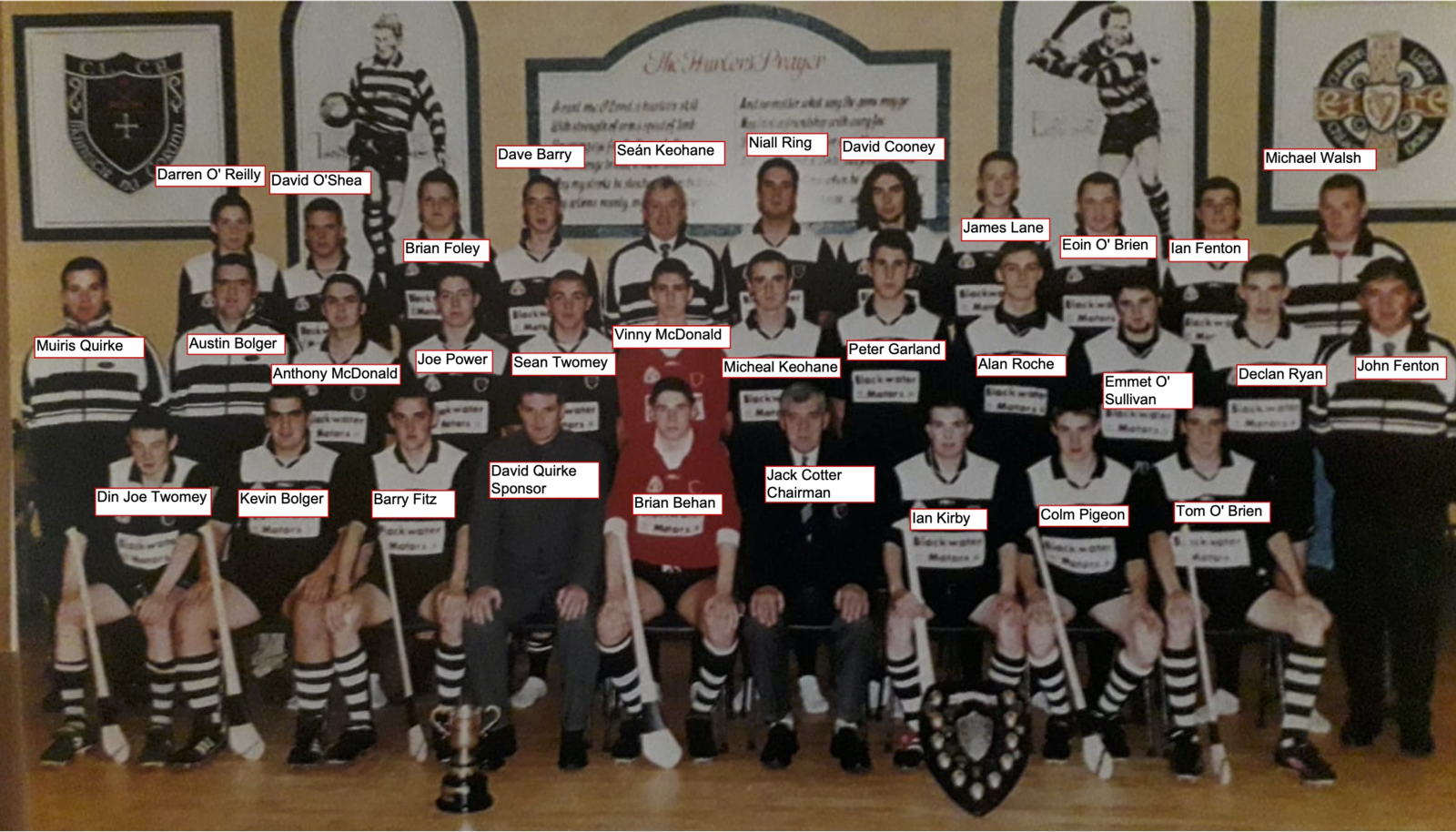
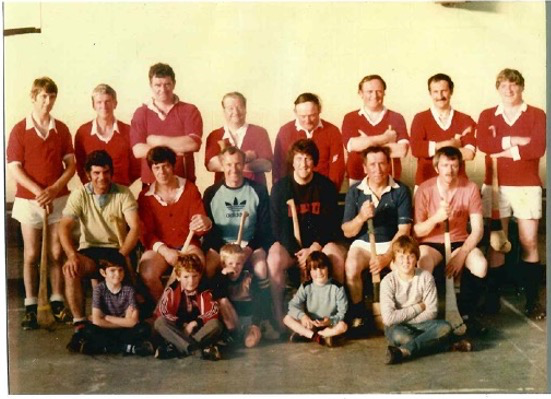
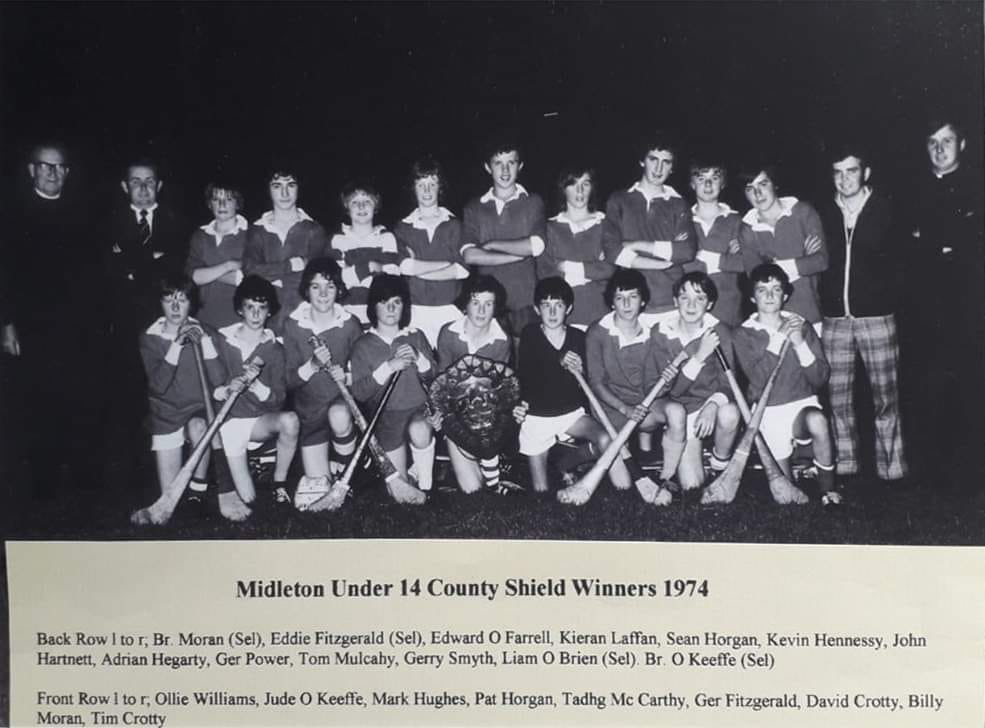
Clonmult Ambush Centenary Commemoration
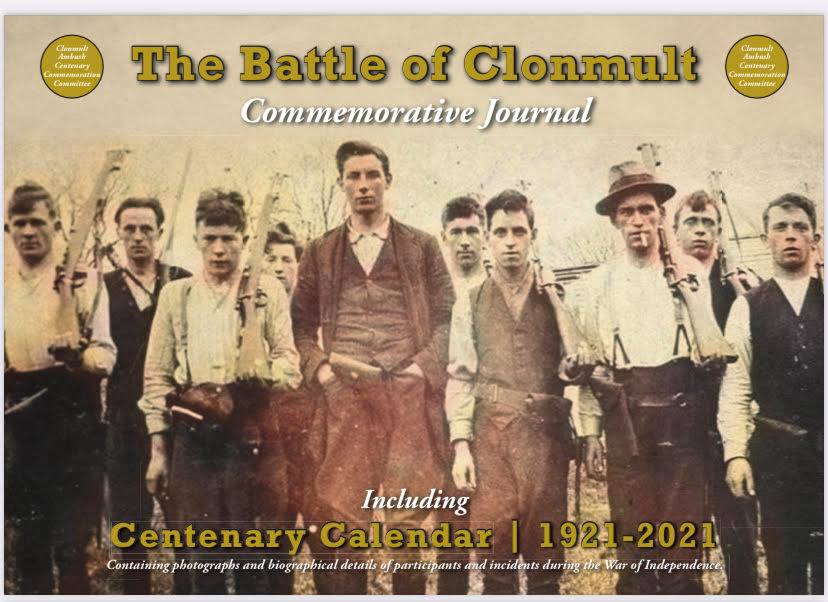
Ag druidim le comóradh chéad bliain Luíochán Clonmult an 20 Feabhra déanfaimid sraith ‘Portraits of Clonmult Patriots’ a athphostáil.
In the run up to the centenary of the Clonmult Ambush on 20 February we will re-post a ‘Portraits of Clonmult Patriots’ series.
This will include a picture and biography of the 15 column members who died during the the War of Independence (12 who died at Clonmult, 2 that were executed at Victoria Barracks and the Column Leader who died at Gurtacrue, Midleton) and those who survived Clonmult on that fateful day.
Many thanks to the Clonmult Centenary Commemoration Committee and their contributors for this fantastic content.
For those not familiar with the Clonmult Ambush and its local and national significance, then visit the Clonmult Ambush Site Facebook Page. There you will see some suggested reading such as the book written by Tom O’Neill titled ‘The IRA’s Worst Defeat’ and the readable and informative Commemorative Journal/Calendar published to mark the centenary of the ambush.
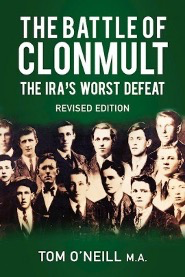
Subject to COVID restrictions other commemoration events will be organised by Midleton GAA.
“Portraits of Clonmult Patriots Series”
Lt Christopher O’Sullivan, Midleton
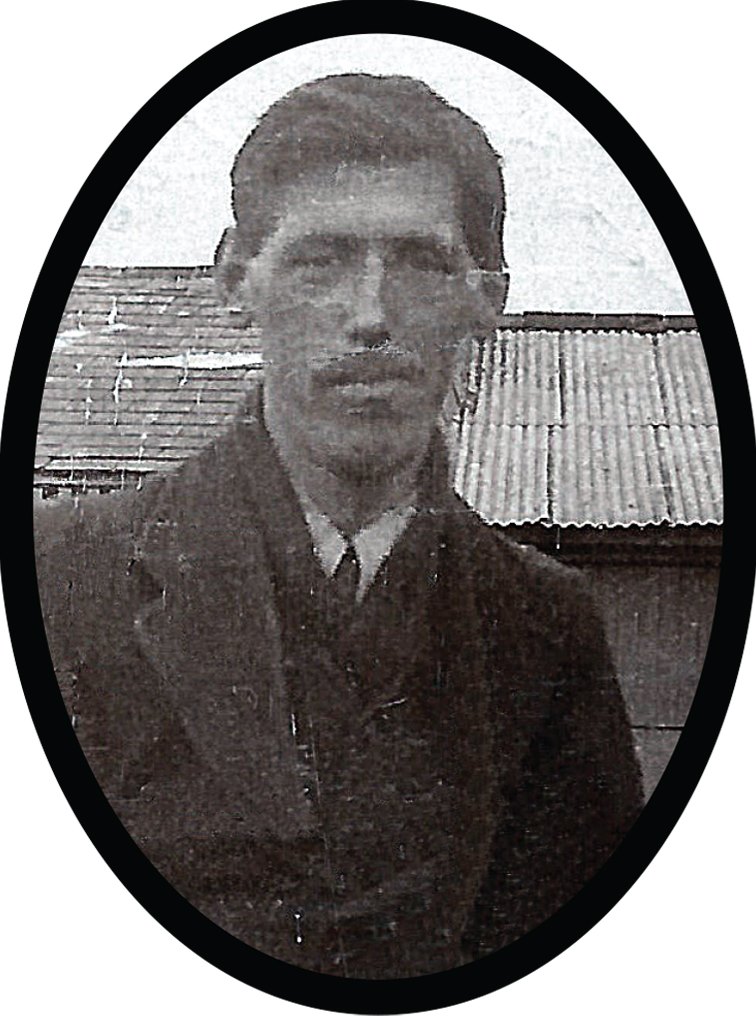

Christopher O’Sullivan was aged 29 at the time of the Battle of Clonmult and was from the Crescent, Cork Road, Midleton. He lived with his widowed mother, Mrs Mary O’Sullivan, who was a retired National School teacher. He was employed as a solicitor’s clerk in Midleton. Christopher was one of five children born to James, who was also a National School Teacher and Mary O’Sullivan. He had one brother Arthur and three sisters Madeline, Josephine and Frances.
As an active member of ‘B’ Company, Fourth Battalion in Midleton and having previously served for three years in the British Army during World War 1, he was promoted to the rank of Lieutenant. He was the only member of the column with previous military service. Because there was no appointment for a lieutenant in the flying column, he was operating as a volunteer. He is not mentioned as having participated in any of the actions involving the flying column prior to the battle of Clonmult on Sunday, 20th February, 1921.
On the afternoon of Sunday, 20th February he was preparing for the march out with the column to their new base near Leamlara. When the farmhouse was surrounded by British soldiers he was with the group trapped inside. He did not participate in the attempted breakout with Capt Jack O’Connell, instead, he provided covering fire for the breakout. Later, when the thatch roof was set on fire and the house surrounded, he was left with no other choice than to surrender. Capt Paddy Higgins took the decision to surrender approximately fifteen minutes after the roof was set on fire.
Lt Christopher O’Sullivan exited the house with his eleven comrades and all were ordered to line up against the east wall of the cowshed. Almost immediately the Auxiliary Police opened fire with their revolvers at close range and killed seven of their twelve prisoners. Lt Christopher O’Sullivan, Volunteers David Desmond, Jeremiah Ahern and his first-cousin Liam Ahern, Donal Dennehy, Joseph Morrissey and James Glavin were all shot dead before a British Army officer regained control of the Auxiliaries, stopped further killings and thus saved the lives of the remaining prisoners.
The strong possibility is that the killings of the IRA prisoners at Clonmult by the Auxiliary Police, was in revenge for the defeat of their Macroom Castle base colleagues, at the ambush at Kilmichael, West Cork, approximately eleven weeks earlier, on the 28th November, 1920.
On Monday morning, 21st February, the National newspapers gave brief details of the battle and had thirteen as the number of IRA men killed. However, due to the confusion of the battle, it is understandable that this incorrect figure was given. In reality, twelve IRA men had been killed and their bodies had been left overnight beside the smouldering ruin of what had been their billet at Clonmult. The British troops returned to collect the bodies on Monday morning around 9.00 o’clock and carried out a more thorough search of the immediate area. The British were convinced that the body of the column commander had been removed by the IRA during the night, this gave rise to the figure of thirteen killed.
The British army trucks were driven down a narrow lane that ran from Carey’s cottage. The remains of the twelve dead republicans were loaded onto the trucks and were conveyed directly to the mortuary located at the rear of the hospital block in Victoria Barracks in Cork. There they were received and labelled for identification by the military doctor on duty, Capt J B Morrison, Royal Army Medical Corps, (RAMC). Capt Morrison carried out an examination on all of the bodies that day. Information on the battle gradually reached the families of the column members on Sunday night and Monday morning. The family of Christopher O’Sullivan saw his bicycle in the back of an Army truck, when it was passing through Midleton. During Monday, a special meeting of Midleton U.D.C. was held and a vote of sympathy was passed to the families of the deceased.
On Wednesday morning, 23 February, a ‘Military Court of Inquiry in lieu of an Inquest’ was set up. Its purpose was to investigate and report upon the circumstances under which the twelve civilians met their deaths. The court having assembled pursuant to order proceeded to view the bodies of the above civilians at the Military Hospital, Cork, and to take evidence on oath. The tenth of the twelve bodies to be identified was Christopher O’Sullivan. He was identified by his sister Miss Francis O’Sullivan of Midleton. She stated that he was her brother, that he resided in Midleton, was unmarried, age about twenty-seven and had no occupation. The medical evidence was that he had been fatally shot through his heart by Crown Forces.
On Wednesday the bodies were released to their families and were removed from Victoria Barracks late that evening. The cortege carrying the twelve coffins travelled together as far as Cobh Cross and from there the coffins of James Ahern and James Glavin were taken to St. Colman’s Cathedral in Cobh. The other ten coffins were taken to Midleton by lorry, where they arrived at about 10.00pm. ‘Crowds had been gathering in the town from 4.00 pm and the church bell had been ringing since about that time. It was a fine, dry, calm night, though somewhat cold, and a deep silence pervading the whole scene at such an hour at night, the event was undoubtedly solemn, and was one calculated never to be forgotten by those who were present on the sad occasion’. The coffins were shouldered from the Cork side of the town to the church, where they were placed in front of the high altar.
Following Requiem High Mass at 10.00 am on Thursday 24th February, the nine coffins of the local men including Lt Christopher O’Sullivan were laid to rest in the Republican Plot. The coffins were draped in tricolours and there were innumerable wreaths.
Lt Christopher O’Sullivan died for Ireland at Clonmult, on Sunday, 20th February, 1921.
Ar dheis Dé go raibh a anam.
Capt Patrick Whelan, Wexford & Cobh
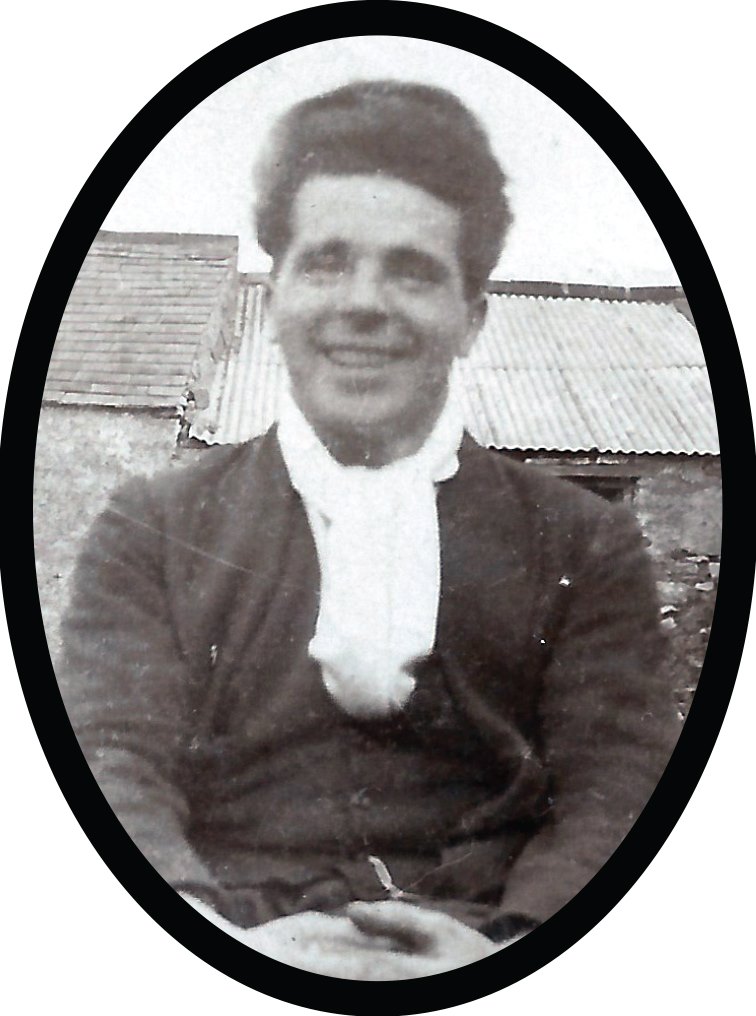
Capt Patrick (Paddy) Whelan was born in Wexford on the 10th February, 1896. He was the eldest of four children born to Thomas and Sarah Whelan. He had one brother Thomas and two sisters Catherine and Margaret Mary. His father was employed by the Commissioners of Irish Lights and when Paddy was eight years old his father was transferred from a Lightship of the Wexford coast to the Daunt Rock Lightship off Cork Harbour. While in Co. Cork the family lived in 16 East Hill, Cobh. In 1911, at the age of fifteen, Paddy began an apprenticeship as a boiler maker in the Royal Navy Dockyard on Haulbowline. In 1911 he also became a member of the Gaelic League in Cobh, then called Queenstown. In 1913 or 1914 he became a member of the Cobh Company of the Irish Volunteers.
When the Irish Volunteers split in 1914, Paddy Whelan and some of his fellow Gaelic League members remained loyal to the ethos of the original force and the goal of Irish independence. They refused to join the Irish National Volunteers.When the Irish Volunteer Company was reorganised after the split, Michael Leahy was appointed company commander. When Michael Leahy was arrested and interned, Paddy Whelan was appointed company commander until Leahy was released. The Cobh Company was designated ‘A’ Company, Fourth Battalion.
During Easter week 1916, Paddy Whelan with other members of the Cobh Company, marched to the Irish Volunteer Headquarters in Sheares Street in Cork. From there he marched with a group of Volunteers to Macroom, hoping to receive arms and equipment that was expected from the gun running ship ‘Aud’. By then the ‘Aud’ and its much needed cargo of weapons and ammunition was on the sea bed outside Cork Harbour. The men returned empty handed to Cork. Towards the end of Easter week, the general mobilisation of Volunteers was cancelled and he returned to Cobh.
During September 1917, Paddy went to live in Belfast with his family, his father had been transferred from Cobh, to a lightship off the County Down coast. He joined the Irish Volunteers in Belfast. Around that time, Paddy began working in the famous Harland and Wolff shipyard in Belfast. While in Belfast he first met Diarmuid O’Hurley, who would later become his company commander and flying column commander. He visited his former company commander Mick Leahy and Martin Corry of Knockraha when they were prisoners in Belfast’s Crumlin Road Gaol.
Paddy Whelan returned to Cobh in 1919 and began working in Hallinan’s Engineering Works in Midleton. He joined the Midleton Volunteer Company and his company commander was Diarmuid O’Hurley who had also only recently moved from Belfast. Midleton was designated ‘B’ Company, Fourth Battalion.
He participated with other members of the Midleton Company, in the successful capture and destruction of Carrigtwohill RIC Barracks in January, 1920. During February 1920 he participated in the capture of Castlemartyr RIC Barracks. While searching a bedroom in the barracks, Whelan found a double barrel shotgun in a box under a bed. Castlemartyr RIC Barracks was not destroyed because it was adjoining two dwelling houses on the Main Street.
On the 8th of May he participated in the capture of Cloyne RIC Barracks. He was positioned with two other volunteers in a grain store directly across the street from the barracks and his orders were to fire at the windows of the barracks. When the RIC garrison surrendered he entered the barracks and found a fully loaded police carbine and a Webley revolver.
Paddy Whelan was not involved in what became known as the Mile Bush ambush on the 5th June 1920. He was cycling from Cobh to Midleton with Mick Leahy at the time and happened to cycle past Mile Bush about five minutes after the ambush had taken place.
On the 26th of August, Paddy was heavily involved in the preparation of an ambush on a Cameron Highlanders lorry, at Churchtown North, (Whiterock), two miles east of Midleton on the road to Youghal. He was involved in collecting the weapons to be used in the ambush. The weapons were the ones taken from Cloyne RIC Barracks. He also participated in the ambush. The intention was to fell a tree in front of the lorry, forcing it to stop. Unfortunately the tree fell a few seconds too late and hit the tailboard of the lorry. Even though the army driver, Pte Hall, was killed by IRA rifle fire, Lieut Beggs, sitting beside him, regained control of the lorry, preventing it from crashing. The officer, who had been shot in the kidney, was subsequently decorated for his quick action.
When it was decided to form a flying column in September 1920, Paddy Whelan was one of the first to join. The column consisted almost entirely of men who were on the run.
On the 11th of December 1920, Paddy Whelan and the other members of the column lay in ambush positions near Aghada, expecting to engage a patrol from Fort Carlisle (Fort Davis), but the British did not appear. From Aghada, they marched to billet for the night in Bertie Walsh’s house in Rock Street, Cloyne. This was a dangerous move as Walsh himself was on the run. The house was surrounded by British troops the following morning and it was only by guile and an aggressive breakout that the column managed to escape. While Paddy was standing in the yard of the house, a Mills grenade thrown by a soldier, landed at his feet. The grenade burst with a dull thud and split in two. It obviously failed to fully explode. He had an extremely lucky escape. There were two similarities with Clonmult, in that there were no sentries in position and the house was surrounded. There was one major difference, the column members escaped from Cloyne, at Clonmult only one escaped. That was also the night of the burning of Cork City by the Auxiliary Police.
Paddy Whelan was involved with the column during the ambush of a joint RIC and Black and Tan foot patrol on Main Street Midleton, on the 29th of December 1920. The eight-man foot patrol left the RIC Barracks at about 9.30 pm and proceeded down Main Street. They were ambushed on the return leg as the patrol was approaching the Town Hall, now the library. During the ambush, Special Constable Martin Mullen, stationed in Midleton and living with his family in Youghal, was mortally wounded. He died of his wounds that night in a house off Main Street. Two Black and Tans, Ernest Dray and Arthur Thorp were also killed.
Paddy Whelan remained with the column until a few hours before the battle of Clonmult on the 20th of February. He was a member of the reconnaissance group that included the column commander and Joseph Ahern that departed Clonmult for Cobh Junction shortly before the arrival of the British soldiers, thus missing the entire battle.
The three officers and Capt Jack O’Connell returned to the battle site around midnight and Capt Paddy Whelan’s best describes the harrowing scene:
The twelve bodies had been collected and placed beside each other with their faces covered with canvas.
‘I (Paddy) undertook the heart-breaking task of uncovering their faces and identifying them, calling out each consecutively. This sad task took me some time, but between sobs of anguish, I managed it. There were two distinct pauses as I went along the row, as I had great difficulty in naming Liam Ahern (Jos. Ahern’s brother) and Jerry Ahern (first cousin of Jos.) I will not even attempt to describe the mental anguish of Diarmuid O’Hurley. All four of us – Diarmuid, Jos., Jacko and myself – sobbed with a terrible grief and sense of loss at the fate that had befallen our beloved comrades, some four or five of whom had bullet holes in the face, just below their eyes, where they had been shot by the Tans whilst prisoners. There was nothing we could do but cover their faces again, and take our sad departure to Leamlara’.
Paddy Whelan, Diarmuid O’Hurley, Joseph Ahern and Jack O’Connell spent the Monday night in Midleton, in Fr Francis Flannery’s house and on the Thursday, attended the funerals. ‘When the internment had been completed, O’Hurley drew his gun, signalled to Paddy Whelan and O’Connell to do likewise, and we then gave our last salute by firing three volleys over the grave. We then made our way quickly out of the graveyard’.
Diarmuid O’Hurley, Joseph Ahern, Paddy Whelan and Jack O’Connell remained together after Clonmult. Because of the loss of weapons and equipment at Clonmult there was no possibility of forming and arming a new flying column.
On the 10th of April the four men along with Michael Kearney, mounted an ambush on a Cameron Highlanders mobile patrol at Ballyedekin, on the Midleton to Youghal road. This was one of the first occasions that the local IRA used a roadside bomb against a Crown Forces patrol. The bomb was remotely detonated using a battery, cable and an electric detonator. There were no known British Army fatalities’. This was the last action against Crown Forces that Paddy Whelan was involved in.
When Comdt Diarmuid O’Hurley was killed north of Midleton on the 28th of May his body was removed to Gurteen near Clonmult. Paddy Whelan was involved in making the arrangements for the funeral to Churchtown North cemetery.
In early June 1921 the company commanders of the Fourth Battalion met in Dungourney to elect a new Battalion commander to replace Diarmuid O’Hurley. Vice Comdt Joe Ahern was selected as the new battalion commander and Capt Paddy Whelan was selected as his second in command. Both men held their appointments and ranks until the Truce on the 11th of July. Paddy Whelan had survived the War of Independence.
On the formation of the National Army in 1922, both officers enlisted and continued to hold their respective ranks.
In Paddy’s Witness Statement June 25th 1956 he wrote “Of the original column, I am the sole survivor. I pray for them constantly, and have shed many a tear over my memories, always when I hear the Soldier’s Song, and particularly when the anthem is played by the Artane Brass Band to the thousands assembled in Croke Park, Dublin. I listen to the thousands singing, but I shed silent tears, and, thinking of my dear, former comrades, pray that God, in His mercy, has seen fit to assemble them with Him in His heavenly home, for they are deserving of eternal happiness. I knew them all intimately, and fail to recall anything but the noblest instincts in good, clean living men-men who were inspired by love of Ireland and who nobly died in her cause. May their souls rest in peace.”
Of the people who sheltered and fed them Paddy stated “Before I finish my story, I feel I must refer to those gallant people who gave us food and shelter during that terrible period of nine months, from October 1920 to July 1921. No narrative of these times would be complete without reference to these people. They were well aware that, by giving shelter to us of the I.R.A., they were risking their lives and their homes. The viciousness and unbridled brutality of the enemy, by taking revenge in reprisals, both official and otherwise, were commonplace throughout the country. Yet, the people rose to the occasion. Their Irish spirit rose to magnificent heights of self-sacrifice, and whenever a natural nervousness existed, that spirit awakened and produced, marvels of heroism. I sincerely hope that future historians will not fail to pay tribute in this respect. Surely, it is not too difficult to picture the dire straits in which the I.R.A. would find themselves if the people failed in their support of the cause, the support which was vital to the success with which the army’s efforts were eventually crowned”.
“I am, after a lapse of thirty-five years, trying to recall the names of some of these gallant families in East Cork who gladly gave us food and shelter, many of whom gave us their own beds that we might sleep in comfort, and amassed debts to buy foods for us. In my opinion, these are the people who deserve special recognition for the unstinted services they so willingly gave”.
Capt Paddy Whelan died on the 24th September 1963.
Ar dheis Dé go raibh a anam.
For further reading, search the Bureau of Military History, Witness Statements (WS).
WS No. 1449, Comdt Patrick J. Whelan.
See also, ‘The Battle of Clonmult’ by Tom O’Neill.
Capt Diarmuid (Sonny) O’Leary, Killeagh
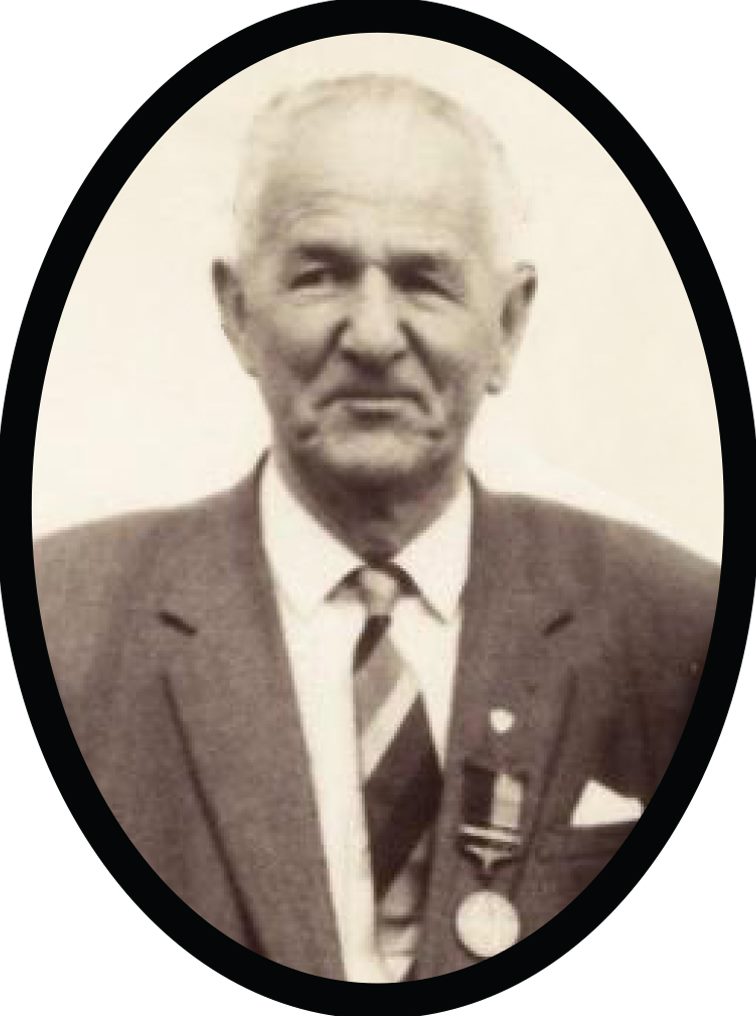

Capt Diarmuid (Sonny) O’Leary, also called Jeremiah, was born in Killeagh, Co. Cork. He had two brothers, Cornelius and Daniel and one sister Margaret. His mother was a widow for a number of years. When the Killeagh Company of the Irish Volunteers was reorganised in 1918, he was appointed company captain. In 1919, the Killeagh Company became ‘J’ Company, Fourth Battalion, Irish Republican Army. ‘J’ Company’s area of operations included Mount Uniacke and Inch.
Following the successful capture of nearby Castlemartyr RIC Barracks, by the IRA, in February 1920, consideration was given to attacking Killeagh RIC Barracks. The barracks was located on the eastern end of the Main Street and on the west bank of the river. Before any plan could be put into operation, the RIC Barracks was evacuated. At this stage the British authorities had recognised that it was impossible to garrison and reinforce the isolated RIC barracks throughout the country. Diarmuid O’Leary burned the evacuated RIC barracks at 6.00 o’clock one morning.
In mid-1920, Diarmuid O’Leary went on the run, because his home had been raided by Crown Forces on a number of occasions. He lived in a number of safe houses in the vicinity of Killeagh, until November 1920.
Towards the end of 1920 he decided to make a solo attack on a Crown Forces vehicle as it was travelling towards Killeagh, from Youghal. He decided to use three sticks of gelignite and a length of fuse wire. He placed the gelignite in a hole he dug at the side of the road. When he heard a Crown Forces vehicle approaching he concluded that it was a lorry. He estimated the speed of the lorry and the speed that the fuse wire would burn, before it would detonate the gelignite. He lit the fuse and to his disappointment the vehicle was a much faster Crossley Tender. The gelignite exploded after the Crossley Tender had been driven past. Diarmuid joined the Fourth Battalion flying column during November 1920. His first action as a member of the flying column was in Midleton. The column commander, Diarmuid O’Hurley, had decided to attack a combined RIC and Black and Tan foot patrol on Main Street, Midleton, on the night of the 29th of December.
The eight-man foot patrol left the RIC Barracks at about 9.30 pm and proceeded down Main Street. They were ambushed on the return leg as the patrol was approaching the Town Hall, now the library. During the ambush, Special Constable Martin Mullen, stationed in Midleton and living with his family in Youghal, was mortally wounded. He died of his wounds that night in a house off Main Street. Two Black and Tans, Ernest Dray and Arthur Thorp were also killed.
During that operation, Diarmuid O’Leary was with other column men on outpost duty on a road leading into Midleton from Youghal. Their mission was to engage any Crown Forces that would be rushing to the assistance of the RIC foot patrol. After the ambush was over, the entire flying column withdrew back to their billet at Kilmountain, east of the town. He was with the column when they set up their billet in the disused farmhouse at Garrylaurence, the site of the battle of Clonmult.
On the afternoon of Sunday the 20th of February 1921, the day of the battle of Clonmult, Diarmuid O’Leary received a parcel of clean clothes from Capt Dick Hegarty. Dick Hegarty had been on week-end leave from the column and had received the clothes for O’Leary. O’Leary was in the house and he had put on a clean shirt, he was using the glass in one of the front windows as a mirror and while looking through the window to his amazement and horror, he spotted British soldiers in the lane leading to the house. He shouted out the alert to the column and very shortly afterwards John Joe Joyce and Michael Desmond were killed near the well.
When Capt Jack O’Connell decided to lead a break out from the besieged farmhouse, O’Leary was one of the four men that agreed to go with him. When the four men rushed out, O’Leary was the last in line. They were met with a hail of bullets. He saw Michael Hallahan and Dick Hegarty being shot down in front of him. He reached the haggard and decided that the best option was to get back into the house. He ran back under a hail of British bullets. The break out was over and only Capt Jack O’Connell had managed to get through the British cordon.
One of the British Army officers, Lieut Hammond, decided to bring the battle to a conclusion by setting fire to the thatch roof of the farmhouse, using petrol and grenades. When the smell of the burning thatch reached the men, the decision was made to attempt to break through the back wall. Bayonets, knives and forks were used for this task and eventually, with the house full of fumes, the hole was made. It was decided that O’Leary would be the first through the hole. Unfortunately, a British army sniper had the rear of the house covered. When O’Leary put his head through the hole he was almost immediately shot in the head, luckily only by a ricochet bullet. Shortly afterwards, he slipped into unconsciousness. As a result he did not witness the end of the battle and the killing of some of the prisoners by the Auxiliary Police.
Because O’Leary had become unconscious, Patrick O’Sullivan and Maurice Moore only managed to get him out of the burning house after the other men had left. This small delay was enough to save their lives. By the time they managed to get out, a British officer had regained control and had prevented the Auxiliary Police from killing the remainder of the prisoners.
Diarmuid O’Leary and the other prisoners were marched across the fields to the military transport and transported to Midleton RIC Barracks. While in Midleton RIC Barracks, O’Leary gave the RIC a false name. He could not remember the name he gave them. This caused confusion for his family afterwards, because, when the list of dead and wounded IRA man for Clonmult was published, O’Leary’s name was not listed. His family believed that he was lying dead in one of the fields.
From Midleton, the prisoners were taken to Victoria Barracks in Cork. O’Leary was taken to the Military Hospital in the barracks, along with the other wounded prisoners. After about a week in hospital he was discharged and moved to the Military Detention Barracks. The following day while he was in the prison exercise yard he met his colleagues that had also been captured at Clonmult.
On the 1st of March, 1921, a summary of the evidence against Diarmuid O’Leary and six of the men captured at Clonmult was taken in Victoria Barracks, Cork. The eighth, Paddy Higgins, was still medically unfit to stand trial. Their trial by Military Court began in the gymnasium of Victoria Barracks, on Tuesday, 8th of March 1921.
Diarmuid O’Leary was the last of the accused to be examined and sworn stated that he was not yet twenty years old and that he was the only surviving son of his widowed mother. He too slept at home on Saturday 19th February and after mass in Ballymacoda on Sunday morning, he met a man named Daniel Murphy. He next met a girl called Rosie McCarthy and she asked him to take a parcel to Clonmult to a man named Dick Hegarty, whom he knew well. He cycled to Clonmult and when he reached the village he saw Dick Hegarty in the distance with four others. He followed them and left his bicycle where the road turns right towards the farmhouse. He did not catch up with them until they reached the farmhouse. He gave the parcel to Dick Hegarty, it had spare clothes in it. He just happened to reach the house a few minutes before the military arrived, therefore, he too was trapped inside. He went onto a small room and he threw himself on top of a bed. The room was to the left of the kitchen and was about eight or nine feet square with a window facing out front. The shooting began and after three or four shots were fired, a dog jumped on top of him. Raising himself suddenly, being afraid that the dog would bite him, he was wounded by a bullet in the head. He could not remember anything afterwards. The next he remembered was going into hospital. He stated that he had no politics and was not a member of Sinn Féin, the Irish Volunteers or the IRA. He further stated that he had met Dick Hegarty about two months before in Ballymacoda and that he didn’t know where he lived.
Cross-examined by the prosecutor he stated that Ballymacoda was in the direction of the sea from Killeagh and away from Clonmult. The lady did not say how she came to have the clothing. She lived between Ladysbridge and Ballymacoda. The nineteenth witness, Rosie McCarthy, the young girl mentioned by Diarmuid O’Leary, sworn stated, that she gave the parcel of clothes for Dick Hegarty to O’Leary, in Ballymacoda, on the Sunday morning. She knew that Dick Hegarty was in Clonmult but she did not know exactly where. She had bought the clothes herself. Questioned by the Court, she stated that she knew that Dick Hegarty was on the run.
The evidence given by Diarmuid (Jeremiah) O’Leary could not have been further from the truth. He was an active IRA man and was fully involved in the column. The truth would have convicted him of a capital offence. Because Dick Hegarty had been killed during the battle, O’Leary had used the evidence that would have been applicable to Dick Hegarty. So instead of Dick Hegarty bringing the clothes to O’Leary, O’Leary claimed he was only in the house because he was delivering clothes to Dick Hegarty.
Their trial concluded on Saturday, 19th of March. The court retired for twenty minutes before returning guilty verdicts in respect to all of the prisoners. Diarmuid O’Leary and two of his colleagues were sentenced to death by being shot. Their legal team lodged an appeal which failed for Patrick O’Sullivan and Maurice Moore, the two men that had brought O’Leary out of the burning house, were executed on the 28th April 1921.
On the evening of the executions, Diarmuid O’Leary was taken into an office in the barracks, where three British Army officers were present. He recalled, “One of them proceeded to read out the sentence of death passed on me and then added that the sentence was commuted to one of Penal Servitude for Life. It is not possible to state the relief I felt at this totally unexpected news.”
Diarmuid O’Leary had been found guilty of levying war and sentenced to death. During his court-martial he denied having any involvement whatsoever with the Republican forces. He also claimed that two of his brothers died of wounds while serving with the British Forces during the First World War. His strategy proved successful in the end.
In an amazing twist, the General Officer Commanding the Sixth Division in Victoria Barracks, Cork, Major General E.P. Strickland, personally intervened. In his letter to Gen Macready, the Commander in Chief Forces in Ireland, Maj Gen Strickland wrote,
To GHQ Ireland:
The accused Jeremiah O’Leary denied that he was a member of any illegal organisation and nothing is known against him here. He was aware that there were rebels in the party at Clonmult when he went there, but there is some doubt whether he was a member of the gang, and under the circumstances it is recommended that clemency be exercised in this case.
Signed E P Strickland, Major General, Commanding 6th Division.
As a result of this request for clemency, Diarmuid O’Leary’s original sentence of death was commuted to Penal Servitude for Life.
Very shortly after the executions of their comrades, Diarmuid O’Leary and four other Clonmult prisoners, John Harty, William Garde, Edmond Terry and Robert Walsh were transferred from the Cork Military Detention Barracks to the ‘Military Prison in the Field’ on Spike Island, which was for convicted republican prisoners and internees. On the 17th of November 1921, all five were transferred from Spike Island to Kilkenny Gaol. Later they were transferred to Waterford Prison from where they were released in February 1922.
Diarmuid O’Leary died on the 26th May 1981 and was laid to rest in Mogeely Old Cemetery.
Ar dheis Dé go raibh a anam.
For further reading, search the Bureau of Military History, Witness Statements (WS).
WS No. 1589, Diarmuid O’Leary.
See also, ‘The Battle of Clonmult’ by Tom O’Neill.




